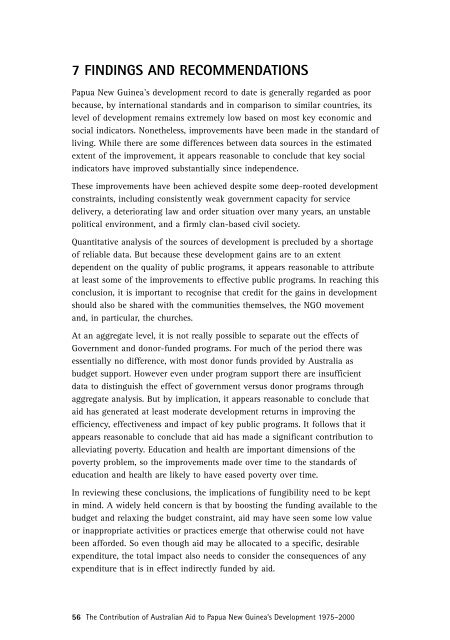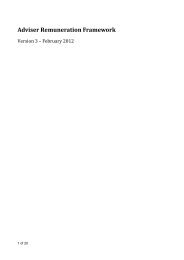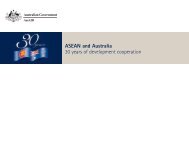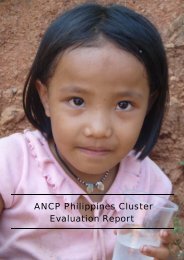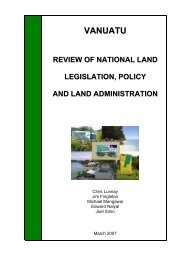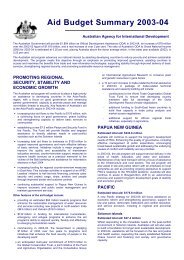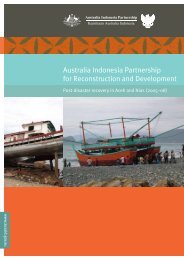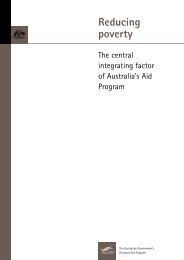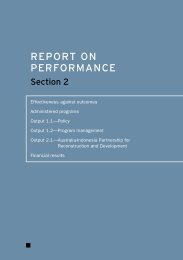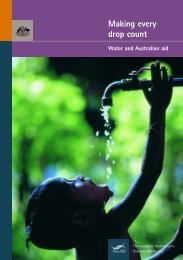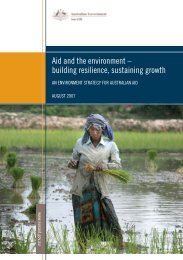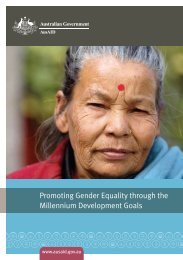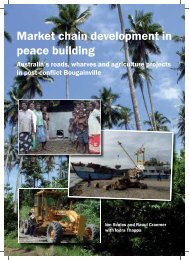Australian Aid to PNG - AusAID
Australian Aid to PNG - AusAID
Australian Aid to PNG - AusAID
Create successful ePaper yourself
Turn your PDF publications into a flip-book with our unique Google optimized e-Paper software.
7 FINDINGS AND RECOMMENDATIONSPapua New Guinea’s development record <strong>to</strong> date is generally regarded as poorbecause, by international standards and in comparison <strong>to</strong> similar countries, itslevel of development remains extremely low based on most key economic andsocial indica<strong>to</strong>rs. Nonetheless, improvements have been made in the standard ofliving. While there are some differences between data sources in the estimatedextent of the improvement, it appears reasonable <strong>to</strong> conclude that key socialindica<strong>to</strong>rs have improved substantially since independence.These improvements have been achieved despite some deep-rooted developmentconstraints, including consistently weak government capacity for servicedelivery, a deteriorating law and order situation over many years, an unstablepolitical environment, and a firmly clan-based civil society.Quantitative analysis of the sources of development is precluded by a shortageof reliable data. But because these development gains are <strong>to</strong> an extentdependent on the quality of public programs, it appears reasonable <strong>to</strong> attributeat least some of the improvements <strong>to</strong> effective public programs. In reaching thisconclusion, it is important <strong>to</strong> recognise that credit for the gains in developmentshould also be shared with the communities themselves, the NGO movementand, in particular, the churches.At an aggregate level, it is not really possible <strong>to</strong> separate out the effects ofGovernment and donor-funded programs. For much of the period there wasessentially no difference, with most donor funds provided by Australia asbudget support. However even under program support there are insufficientdata <strong>to</strong> distinguish the effect of government versus donor programs throughaggregate analysis. But by implication, it appears reasonable <strong>to</strong> conclude thataid has generated at least moderate development returns in improving theefficiency, effectiveness and impact of key public programs. It follows that itappears reasonable <strong>to</strong> conclude that aid has made a significant contribution <strong>to</strong>alleviating poverty. Education and health are important dimensions of thepoverty problem, so the improvements made over time <strong>to</strong> the standards ofeducation and health are likely <strong>to</strong> have eased poverty over time.In reviewing these conclusions, the implications of fungibility need <strong>to</strong> be keptin mind. A widely held concern is that by boosting the funding available <strong>to</strong> thebudget and relaxing the budget constraint, aid may have seen some low valueor inappropriate activities or practices emerge that otherwise could not havebeen afforded. So even though aid may be allocated <strong>to</strong> a specific, desirableexpenditure, the <strong>to</strong>tal impact also needs <strong>to</strong> consider the consequences of anyexpenditure that is in effect indirectly funded by aid.56 The Contribution of <strong>Australian</strong> <strong>Aid</strong> <strong>to</strong> Papua New Guinea’s Development 1975–2000


